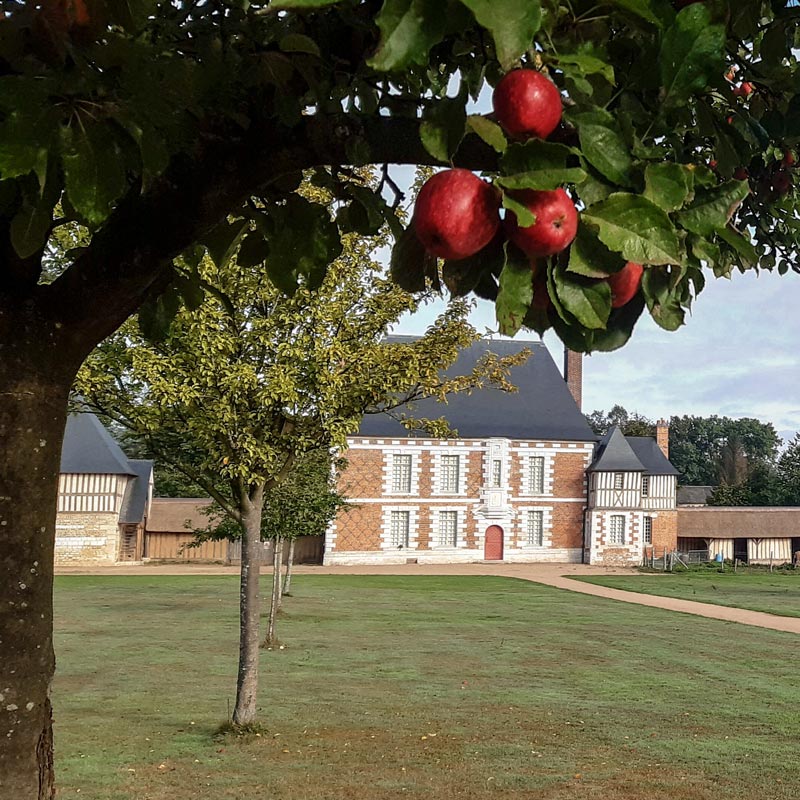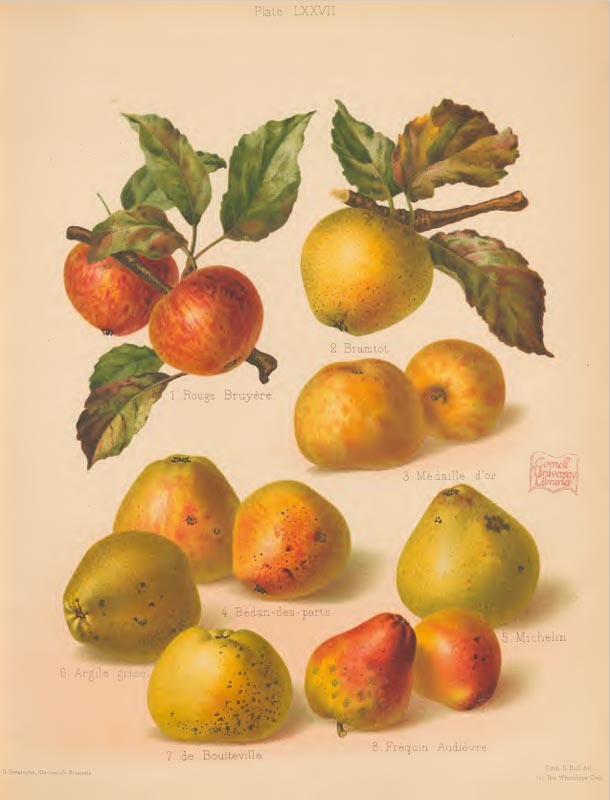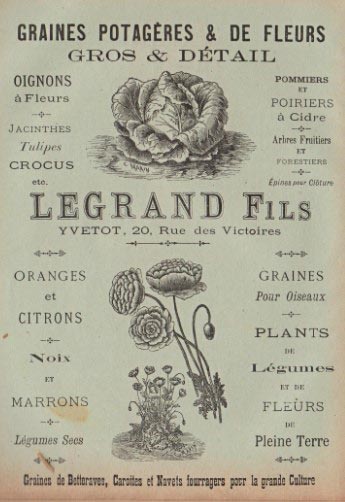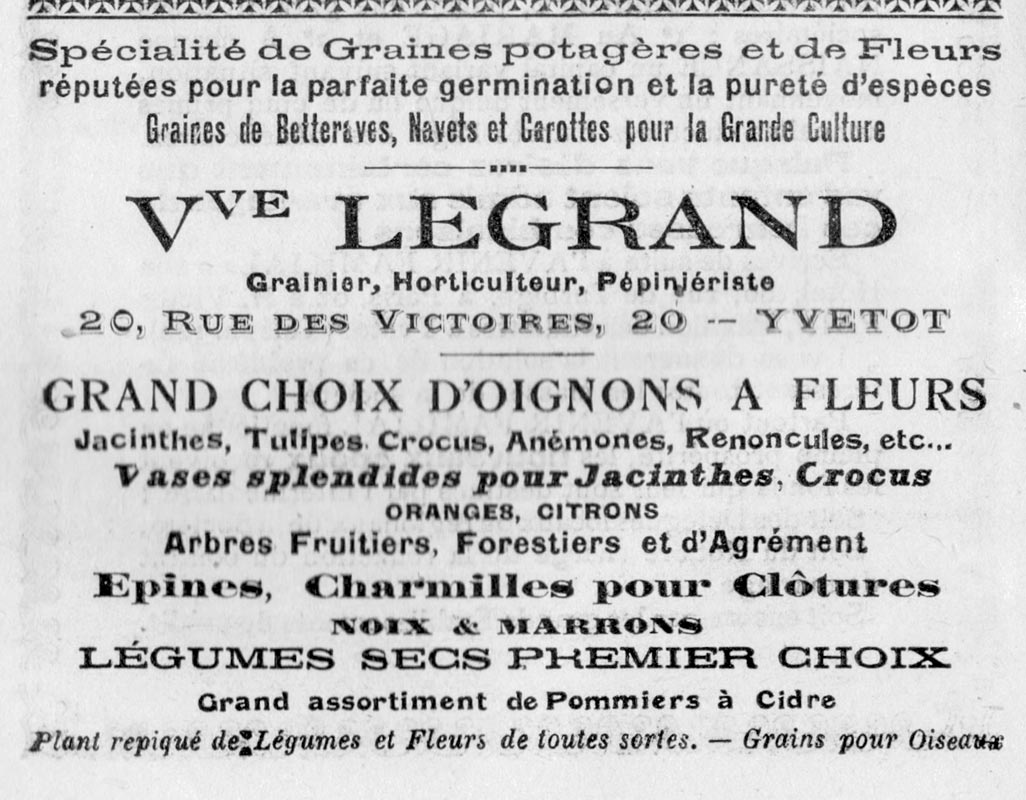M.Legrand – Incubator and Creator of the Michelin
By Pascal Levaillant and Marie-Thérèse Mériot
Yvetot, once one of the high places of the cider apple : The apple history of Yvetot, home of the Legrand family.
Yvetot, a former principality and ‘tax haven’ until the French Revolution, flourished thanks to the textile and drinks industries, trade in cereals, and its plant nurseries. The nineteenth and twentieth centuries brought cider works and distilleries (Calvados Boulard), dairies, printing works, Astra margarine, Bocquet mustard, sawmills, and Ozona clothing factories.
In the 11th century and 12th centuries the term apple appears in the French language in the song of Roland in the 11th century and the Crusaders brought the skill of grafting to Normandy.
In 1096 the “Sire of Yvetot” left with Robert, Duke of Normandy, for the Holy Land during the Crusade. They returned in 1099. G.David-Marescot believes that it was from this time that the first orchards were created in the Pays de Caux.
“As for the picking of wild fruits, it would have been practiced, according to other authors, until the 11th century, in the woods where apple trees grew in abundance in their natural state. L.Deslile reports that in 1183, Robert, Count of Meulan, authorized the monks of Jumièges, in the Seine valley, to pick apples in the forest of Brotonne (ten kilometers from Yvetot across the Seine) for their drink and that of their servant”.
From the Middle Ages, Normandy became the main orchard in France. The real development of the cider apple tree began in the fifteenth century in the country of Caux. The drink (light cider obtained in the second pressing after soaking the pomace) was like ditch water, often unsuitable for consumption. G. David-Marescot mentions that the ‘fief de Verger’ (orchard estate) was already located – on February 3, 1428 – in the parish of Saint-Clair-sur-les-Monts and the kingdom of Yvetot.
The 16th century saw the end of the kingdom and the advent of the principality of Yvetot, under Martin 1st of Bellay. Beaucousin, historian of the principality of Yvetot, quotes : “In the parish of Sainte-Marie-des-Champs and Saint-Clair-sur-Les-Monts, there is a part of an estate named Verger (the orchard), belonging to Marc de Houdetot, held by Roy nostre sire”. This land owned by the Houdetot family would have been obtained by a royal gift according to G.David-Marescot.
Records of Yvetot from 1566, transcribed by Beaucousin from old French in 1874, describe property owned by a man named Charles Legrand, including land near the manor of Verger, in the parish of Sainte Marie des Champs, and in Refigny, some adjoining orchards. This is a family name that centuries later plays an important part in the history of cider apples.
Yvetot had a long tradition of wholesale and retail sale of beverages and liqueurs, which originates in the mid seventeenth century.
In the 18th and 19th centuries Yvetotais nurserymen worked on the strains of cider apple varieties. Trudaine and Turgot are credited with founding the first Agricultural Society in the area around Paris in 1761. After Paris came Nantes, Lille, Rouen, and Le Havre, and in 1863 the Horticultural Society was formed in Yvetot. Yvetot had a cider house.
In the 20th century most of the nurseries in Yvetot have since become allotments or private gardens.
At the beginning of the 21st century, in the courtyard of the Manor of Fay, the City of Yvetot replanted apple and pear trees.
Yvetot nurseries and the famous Legrand nursery, by Michel Traversat
The Pays de Caux is a high land of excellence for press apples, fruit trees for cider apples, a territory that saw the birth of Pierre-Michel Legrand.
The ’Caux’ is a massive plateau plunging into the sea by vertiginous cliffs. This austere country is frequently beaten by gusty winds. These closed hovels are delimited by slopes planted with trees; they contain at the inside, in addition to the farm buildings, more or less large meadows planted with apple trees. Farmers have always planted their trees.
The Yvetot Arrondissement Horticultural Society was founded on December 9, 1863.
In 1865 two years after its foundation, the Society counts Mr. Legrand, horticulturist in Yvetot, amongst its members. He later became curator and archivist in 1877.
The Society held its first horticultural exhibition in June 1865, with the activities of the Society clearly identified : ‘Having Horticulture as its object, The Society studies, by analysis and cultivation, the best varieties of fruit and propagates them, in particular cider apples.’
By November 1891, the officers comprised two horticulturists, Mr. Le Mail senior (vice-president) and Mr. Valentin (curator and archivist), and a nurseryman Mr. Legrand senior was also vice-president.
Mr. Pierre-Michel Legrand was born in Yvetot in 1821. He propagated his first seedling apple trees around 1840 . His father, whom he succeeded in 1850, was himself a nurseryman, promoting large plantations of cider apple trees in this town. Pierre took over the management of the family business at a difficult but critical time because over the previous two decades it had been noticed that some of the most esteemed apple varieties in Normandy had experienced a gradual decline in health, indicating exhaustion through old age.
The Societies of Agriculture and Horticulture of the Seine-Inférieure were consulted on how to remedy this calamitous state and were of the opinion “that it would be necessary to think of looking for new and young varieties which could advantageously replace those whose time is over.”
The investigation, which lasted from 1825 to 1843, consulted a large number of specialists, without much result. It was not until 1862 that the Société Centrale d’Horticulture de la Seine-Inférieure decided to organise the serious in-depth study of the fruits of the press, and appealed for help in this difficult enterprise from all those who could be interested in the cultivation of cider apple trees. Mr. Legrand was one of these: the sole object of his concerns was the replacement of the best of the varieties, the Doux à Lagniel or Vagnon, exhausted and no longer giving good fruit, by a variety regenerated from the same species.
His convictions as a sower appeared so sincere, so profound, that they convinced the Société d’Yvetot to open, in 1871, a special competition for seedling cider fruits ; the gold medal being successively awarded to Mr. Godard, to Mr. Dieppois, horticulturist at Yvetot, and to Mr. Legrand himself.
A little later, Mr. Legrand bought a piece of land where he only planted the mother plants of his most deserving gains in order to obtain, by hybridization, highly perfected varieties. Several of these seedlings became beautiful trees, laden with very beautiful fruits. A few were propagated and made available commercially.
This work of such importance continued without interruption for more than thirty years, and his perseverance attracted the attention of other societies. Between 1862 and 1877, he received 17 medals and in 1878, at the Universal Exhibition in Paris, in addition to the gold medal for one of his varieties, he was proclaimed the first winner of the International Press Fruit Competition. From 1881 to 1888, there were four new gold medals and two of silver-gilt and in 1888, Mr. Legrand was made a Chevalier du Mérite-agricultural. Still not resting on his laurels, there was more success for his elite varieties in the following decade, culminating with a final gold medal awarded by the Western Pomological Association.
Mr. Legrand died on November 2, 1896, aged 75. The collection of elite varieties he had raised could be found at his death almost everywhere in France. They are also part of most of the research orchards of England, Austria, Belgium, Holland, Spain, Switzerland, Luxembourg and some American states. His son, a former student of the Ecole d’Horticulture de Versailles, continued his father’s work.
In ‘History and improvement of apple trees and especially of cider apples’, by Auguste Chevalier published in 1921, the author also explains the role played by Bouteville and Hauchecorne in the improvement of cider apples and the decisive role of chemistry in the process of making cider. Hauchecorne (1824-1905) was an Yvetot pharmacist.
Normandy is currently the most important apple growing center in the whole world. This culture does not aim here to produce table fruit, compotes, dried fruit or vinegar, but it tends almost exclusively to the production of a hygienic drink, cider, widely consumed in the French provinces which make little or no wine, that is to say Normandy, Brittany, Maine, Artois. Twelve departments each produce more than 100,000 tonnes of apples each year for the manufacture of cider and cider brandy, or calvados. The other countries of the globe which make cider are in England: the counties of Herefordshire, Devonshire, Wales; in Spain: the Basque Country (Biscay, Navarre, Guipuzcoa) and Castile; in Germany.
In 1872, the Board of Directors of the Congress thought that the studies of declining cider apple varieties instigated by the Société d’Agriculture de la Seine-Inférieure were sufficiently advanced for a comprehensive work on the varieties of press fruit and on cider to be written.
This was the origin of the very important work of L. de Boutteville and A. Hauchecorne, ‘Le Cidre’, published in Rouen in 1875. It is a work of great and lasting value, with a precise manner of describing the varieties which they had adopted and the innovative methods of chemical analysis which A. Hauchecorne had first devised to determine the value of each sort of press fruit.
The study by L. de Boutteville and A. Hauchecorne led to research in all countries where the cider apple tree was grown. It focused attention upon the old elite varieties […] it encouraged some nurserymen in the Rouen region to undertake the creation of new varieties of cider apple trees having increasingly high saccharin content. About a third of the varieties of cider apple classified by the French Pomological Association at the beginning of the twentieth century were obtained by the skilled practitioners responding to the call of the Société d’Agriculture de la Seine-Inférieure, including Ambrette and Marabot obtained by Legrand.
The elite collection of cider apples raised by Mr. Legrand is set out in ‘Le Cidre’ and Auguste Truelle’s later ‘Atlas of the best varieties of Cider Fruits’ (1896). It comprises :
Ambrette
Argile Nouvelle
Bedan-des-Parts *
Belle-Cauchoise
Binet-Gris
Boutteville *
Michelin *
Pomme Bramtot *
Peau-de-Vache Nouvelle
Pomme Marabot
Pomme-Ridel
Rosine
Rossignol
*These apples were amongst those selected to be taken to England by the Woolhope Club in 1884.
Links to the history and bibliography of the elite collection of cider apples.
Michelin is described in Auguste Truelle’s ‘Atlas of the best varieties of Cider Fruits’ as Yellow-green fruit, very firm, bitter-sweet, “excellent”.
The very active Pomological Association of the West was created in 1883. Many authors contributed to drawing up, towards the end of the 19th century, the inventory of press fruits. Among the most important are : de Chambray (1765), Renault (1795), Dubois (1804), Odolant Desnos (1829), de Brebisson (1858) and especially de Boutteville and Hauchecorne (1875), Hérissant (1893), Power (1893), Trowel (1895), Ragaine (1900), Lecoeur (1914), Warcollier (1920).
We must also mention the names of certain nurserymen who very effectively propagated the good varieties, such as Chasset, Baltet, who published a lot, Godard, Legrand, Lacaille, Baumann, Boisbunel, etc.
Archives show the legacy of the work of Mr. Legrand P.M. and the family nurseries.
The Legrand nurseries stood at Doudeville Road in Yvetot, recorded on a cadastral map in 1807. Later, Pierre-Michel’s son Henri operated from a site at 20 Rue de Victoires in downtown Yvetot.
In 1922, a large assortment of cider apple trees were still sold there.
Sadly, today there is no longer a Legrand nursery in Yvetot, but Pierre-Michel’s legacy continues in the cider apple varieties he reared from seed more than a century and a half ago, including the pre-eminent Michelin apple.
In France, in Seine-Maritime for example, we recently found the Michelin of Legrand with owners like Mr. and Mrs. Monville of Therouldeville near Fécamp and we hope to observe it soon also in the conservatory orchard of Brémontier-Merval in the Pays de Bray and elsewhere.
Across the Atlantic, today the county of Charlevoix is trying to establish in Canada at Petit-Rivière-Saint-François new varieties of cider apples, including those from the Pays de Caux including Bramtot, Michelin de Legrand and Medaille d ‘Or de Godard, another nurseryman from the former Seine-Inférieure.
To conclude, we are now trying to complete the story of the Michelin apple’s journey to Germany, the Netherlands, Austria, Spain… and especially to its place of creation in Yvetot, almost 150 years ago, where it possibly remains very discreet in an orchard or in a courtyard out of sight.
The search continues…
About the authors of this article:
Marie Thérèse Mériot is a former certified biology-ecology professor at LEGTA, Auzebosc-Yvetot and Pascal Levaillant, artist-botanist, is a member of the Central Society of Agriculture, chronicler of the history of the plant heritage of Yvetot and the former principality, and member of the association “Faire Vivre le Manoir du Fay”.
This Journal of Apples article accompanies our Apple Story ‘Michelin and The Girls the French mother of the English cider industry’. This story includes images of models of apples crafted by Somerset artist Lottie Sweeney for Apples & People, watercolours from the Herefordshire Pomona and Bulmer’s Pomona, a 1944 painting by Evelyn Mary Dunbar of Land Girls from the collection of Manchester Art Gallery, paintings by Somerset cider apple expert Liz Copas, an 1898 photograph of Henri Michelin, and one of the medals awarded to the Woolhope Club at the Rouen Congress.
References:
- Michel Traversat, les pépinières, étude sur les jardins français et sur les jardiniers & les pépiniéristes, ANRT, thèse à la carte, Paris, 200, 436-445.
- Poires et Pommes, fruits de pressoir, Parcs Naturels Régionaux de Brotonne et de Normandie-Maine, 1982, p.9-10
- Patrick Lebourgeois, Le pays de Caux, vie et patrimoine, 3e édition augmentée, le cidre, Editions des falaises, Rouen, 2015, p.44
- G.David-Marescot, De César à Henri IV au pays des Calètes (Pays de Caux), brochure, Décembre 1955, p.86
- Auguste Beaucousin – Registre des fiefs et arrière-fiefs du bailliage de Caux en 1503
- A.Lestringant – Société de l’Histoire de Normandie, Rouen, 1891
- Bulletin de liaison du « Cercle d’Etudes du Patrimoine Cauchois », Robert Tougard, la Gazette du patrimoine cauchois, n° 3– 2ème Semestre 1994, p.8
- Daniel-Charles Trudaine Comité des travaux historiques et scientifiques
- Journal d’agriculture pratique, de jardinage et d’économie domestique 1837-1908
- Auguste Chevalier – Histoire et amélioration des pommiers et spécialement des pommiers à cidre – Auguste Chevalier 1921
- L de Boutteville et A Hauchecorne – Le cidre, traité rédigé ….de 1864 à 1872 par
- Hogg and Bull –Herefordshire Pomona and also in Herefordshire Pomona
- Philippe Marchenay – Ethnobotanique et conservation génétique : l’exemple des arbres fruitiers
- Journal d’agriculture traditionnelle et de botanique appliquée. Année 1981, 28-2, pp. 85-158
- L’association du domaine de Merval
- Des essais de pommiers à cidre au Québec (PDF in French)
- Les variétés de pommes à cidre mises à l’essai à Petite-Rivière-Saint-François, comté de Charlevoix, Québec, Canada1 – Par Claude Jolicoeur (PDF in French)
Links to the history and bibliography of cider apples, obtained from seed by M.Legrand at Yvetot, on the Bibliothèque Nationale de France website:













 ATX 2012 ‘Apple Varieties’
ATX 2012 ‘Apple Varieties’ Apples & India From temperate to tropical, exotic to everyday by Priya Mani
Apples & India From temperate to tropical, exotic to everyday by Priya Mani